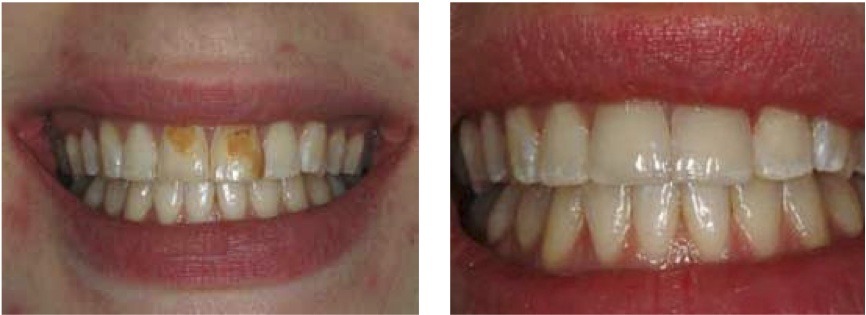A veneer is a thin layer of porcelain made to fit over the front surface of a tooth, very much like a false fingernail fits over a nail. Sometimes a natural color composite material is used instead of porcelain. It can be used for making your smile even, build up the teeth to make them bigger and fill in gaps between teeth. The composite veneer is not as tough as porcelain or ceramic and may discolor sooner than porcelain and ceramics and requires more cleaning. They do, however, look very good and cost a fraction of the price.
Veneers can improve the colors, shape, and position of teeth.
A precise shape and shade of porcelain can be chosen to lighten the upper front teeth or to reshape them. It can make a chipped tooth look intact again- the porcelain covers the whole of the front of the tooth replacing the broken part.
Veneers are often used to close small gaps when orthodontics is not suitable. If one tooth is slightly out of position, a veneer can be fitted to bring it into line with the rest of the teeth.
Veneers can protect teeth from further damage caused by acid in foods and drinks or from acids in the stomach that cause the teeth to wear away. The teeth become thin and weak and can be protected by veneers.
How are teeth prepared for a veneer
Some of the outer enamel surfaces of the tooth will be removed, to ensure that the veneer can be bonded to the tooth permanently. The amount of enamel to be removed is minimal. The tooth is prepared in two stages. The first stage will involve removing a small amount of enamel and taking an impression of the tooth. The impression is sent to the laboratory where they will reproduce a veneer to fit the tooth. We will place a temporary veneer on the tooth to protect it against sensitivity. A visit to the laboratory is essential to make sure the color is matching the adjoining teeth and will look natural. The second stage will involve placing the veneers on the required teeth with a bonding material.
How long will a veneer last
Veneers can last for some years but they can chip or break, just as your own teeth can. People who grind their teeth or clench put more stress on the teeth and the veneers and the life span will be shorter.
What happens after a veneer is fitted?
Some minor adjustments might be needed to make sure that your bite is correct. We would like to recall you one month after to make sure you are happy with the fit and function well with the new veneer.
Prices
REGULAR VENEERS
FROM 69 USD
Direct veneers are recommended for patients with chips, yellowness, the disproportionate size of teeth, wedge-shaped defect, malocclusion, a diastema, uneven dentition.
CERAMIC VENEERS
FROM 165 USD
They allow you to correct the irregular shape of the teeth, remove the gaps between the teeth, get rid of chips, hide darkened teeth, quickly fix minor dentition defects. The thickness of such veneer is about 0.5 mm; they fit the tooth tightly, practically not thickening it. Research has shown that veneers can last more than 20 years, and all these years your smile will be impeccable.
HIGH-ART VENEERS
FROM 320 USD
What are veneers?
Veneers are thin slices of porcelain. These are precisely made to fit over the visible surface of front teeth, very much like a false fingernail. There are also ‘composite’ veneers and these can be completed in just one visit.
Why might I have a veneer?
Veneers are an ideal way of treating discolored or unsightly teeth, closing gaps between front teeth, or repairing chips and cracks.
What are veneers made of?
Porcelain veneers are made by a dental technician, using impressions taken by the dentist. The veneers are made in the laboratory and bonded to the tooth to form a strong and natural-looking repair.
Composite veneers can be completed in one visit and involve bonding tooth-colored filling material to the front of the tooth. Although these veneers are slightly more prone to staining and have a shorter life, they are easily replaced.
Can I use veneers to close the gaps between my front teeth?
Yes. Again, using either tooth-colored material or porcelain, the dentist can change the shape or size of the tooth very slightly, closing the gap between the teeth.
Will my tooth have to be drilled?
Veneers usually need very little work on the tooth itself, and in many cases don’t even need an anesthetic.



